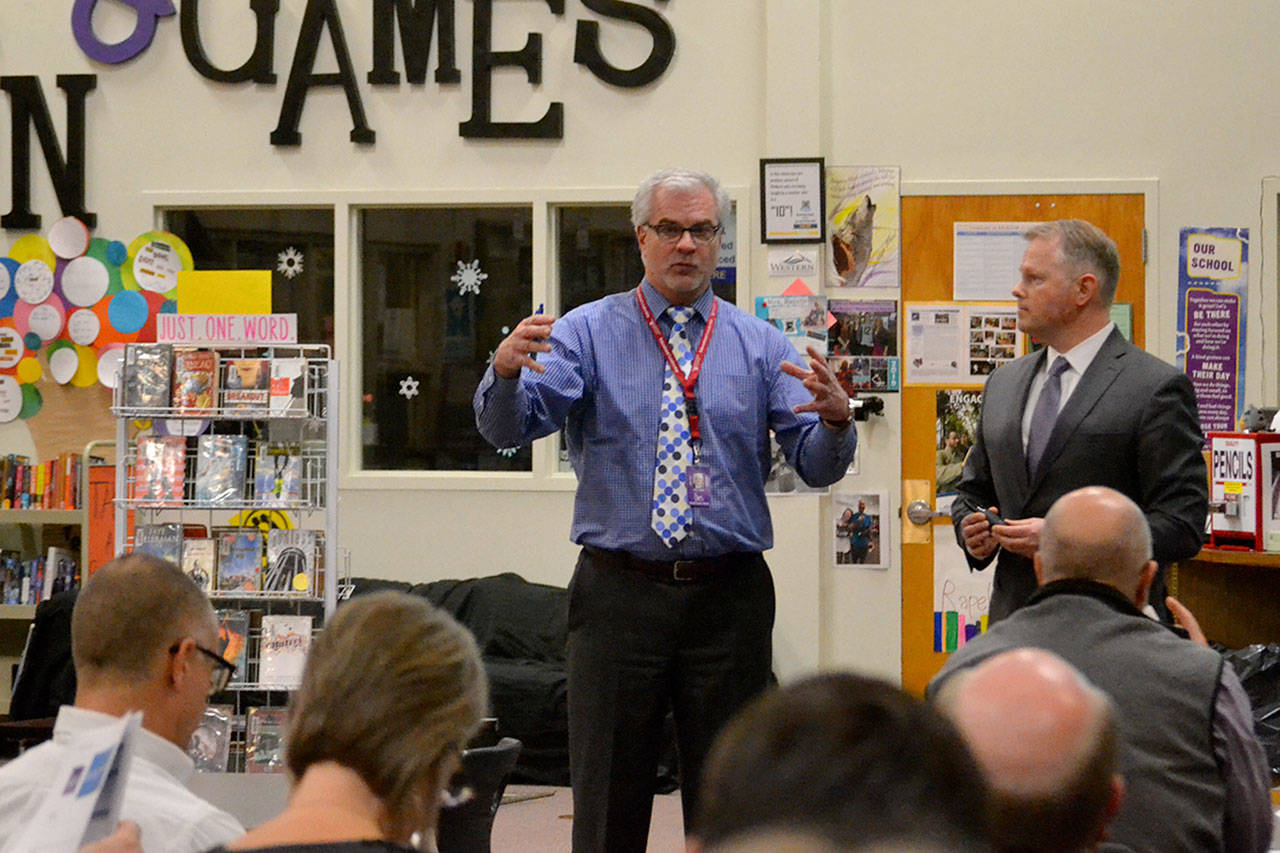Public discussions are beginning once again for the future of Sequim School District’s facility needs.
Where those talks go, however, depend on the interest level from the community, Sequim schools superintendent Gary Neal said.
With the district’s new central kitchen along Fir Street set for completion in February, school leaders hosted a forum kick-off on Jan. 14 in the Sequim High School Library, opening the door to conversations about potential bond and/or levy options for new school facilities.
“We’re moving on down the road,” Neal told the audience of more than 30 people at this week’s meeting.
Phil Partington, regional coordinator for Office of Superintendent of Public Instruction, joined Trevor Carlson, managing director for PiperJaffray — a bond underwriting company — and Bernie O’Donnell, Vanir’s northwest area development manager, to give brief talks about the bond and levy process for schools and the state’s climate for passing new construction.
Sequim voters have varied their support for bonds and levies in recent years. Each of Sequim’s most recent four school bond attempts failed to meet the 60 percent super-majority needed, including an April 2014 proposal for $154.3 million, and proposals in February 2015 ($49.3 million), November 2015 ($49.3 million) and February 2016 ($54 million).
The last bond voters approved was for $25 million in February 1996 to build Sequim Middle School along with new classrooms (H-building) and a playfield at Sequim High School.
Educational Programs & Operations levies typically pass in Sequim, with its last five attempts exceeding 60 percent — despite now needing only a 50 percent plus 1 majority.
Sequim’s levy rates have been $1.59 per $1,000 of assessed property value in 2018, $1.43 in 2017 and $1.52 in 2016, and reached high points in the past 20 years at $2.30 in 2013 and $2.50 in 1999.
The school’s capital levy from February 2017 — one that generates $5.75 million over three years (2018-21) to fund the new central kitchen and demolish the Sequim Community School — passed with 67.6 percent of ballots cast.
Comparison
Last year, Carlson said about 60 percent of Washington state’s proposed bonds failed in 2018, while 58 percent passed in 2017 and 55 percent in 2016.
“This is not an easy game,” he said.
Aaron Reno, a fifth grade math teacher at Greywolf Elementary School who teaches in the school’s library because of lack of space at the Carlsborg school, asked Carlson if there’s a financial downside between going for a bond or capital levy.
With a capital levy, Carlson said, a school district can receive funds all at once while a bond can spread payments over a period of time.
“(For a capital levy) it’s a loan and there’s interest,” he said. “You can get projects out on time before construction inflation eats you alive.”
Carlson compared a bond to a 20-year mortgage.
“Your pain is less but it goes on for a long period of time,” he said.
Bond dollars come in on a periodic basis, Carlson said, and it’s going to be an elongated construction cycle.
“In a rising cost construction environment, it could cost you hard dollars more later on by running a bond,” he said.
It’s up to voters if they can afford more now to avoid more costs later, Carlson told the audience, and that it’s “extremely problematic to build an elementary school with a capital levy.”
He said there’s no limit to how much the school district can ask for a capital levy, but if the millage rate for residents doubles or triples, will you get “yes votes?”
“My guess is no,” Carlson said.
Assessment
Residents in Sequim School District’s homes are assessed at about $4.8 billion at a $1.69 rate per $1,000 assessed home value in 2019, Carlson estimated.
Carlson said districts can mix and match bonds and levies.
Some of the comparable school districts with assessed values had higher tax rates in 2018 because they had concurrent bonds and levies, including Ferndale at $4.3 billion assessed value at $4.32 per $1,000, Longview at $4.8 billion and $4.39, and Arlington at $4.2 billion and $4.68.
In various conceptual bond estimates, Carlson said Sequim could ask for $40 million for new construction and homeowners could tentatively see a $0.64 increase in 2021 tax levy rates from 2020.
Additionally, for a $60 million project it could go up $0.89 in 2021, or $1.13 for an $80 million plan.
Next steps
After the meeting, Neal said they continue to gather information on construction projects and no determination has been made for any future project.
“There’s no timeline,” he said. “We want to see the interest levels. We’re anxious to get something going. (The school board) will talk in the near future.”
Sequim School Board president Brian Kuh told the audience he’s excited for the future.
“I’m excited to work with Gary to get the numbers and see where we’re at,” he said.
Neal asked participants to invite at least one person to come to the next forums.
“People support what they help create,” he said.
“We have a strategic vision, but I don’t have a preconceived vision of what it needs to look like,” Neal said later. “My mind is not made up. The group’s mind is what will move this thing forward.”
For more information on the Sequim School District’s future forums, visit www.sequimschools.org or call 360-582-3260.
Reach Matthew Nash at mnash@sequimgazette.com.



